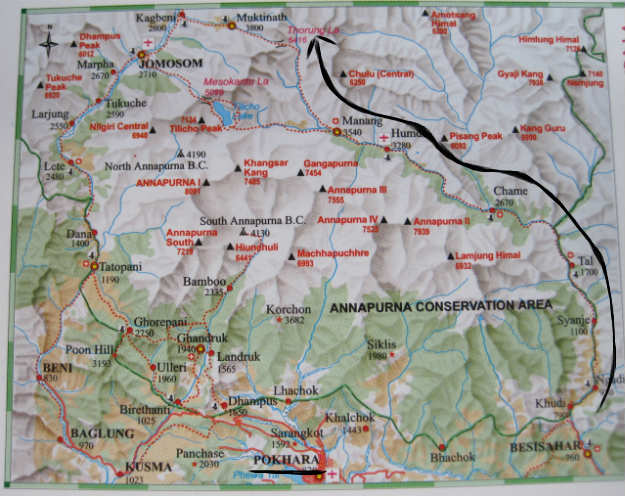
Not the greatest map, I'm sorry. I'm dealing with tenuous internet connections here
Announcement: I have finally completed the Annapurna Circuit in the Himalayan mountains of Nepal.
Thank you. It’s one of the greatest accomplishments of my life, right up there with getting a live person on the phone from my bank once.
This trip was the missing half to one 19 years ago where I flew from Pokhara to Jomsom, walked up to Muktinath and then down the western half of the route back to Pokhara. I dont know why I did that; I do vaguely remember being called a sissy, but it is indeed good to push myself once in a while.
This time I did the eastern half, walking 112 km (70 miles) in 10 days (including one rest day) from 840 meters (2775 feet) to 5416 meters (17,770 feet). The last day I went up from 4450 meters (14,600 feet) to 5416 meters and then down to 3800 meters (12,468 feet). 5416 meters is way up there. It’s the highest I’ve been since Amsterdam, 1997 (rimshot!)
For all of you who have seen me in the flesh and wonder about my ability to carry a 7 or 8kg (about 16 lbs without water) backpack in the mountains for 10 days, carrying a backpack is what I do! When I’m not in the mountains with my backpack, I am traveling with my backpack. I am a horse with that thing. I am always lugging it around, sometimes for hours a day, especially when hitchhiking.
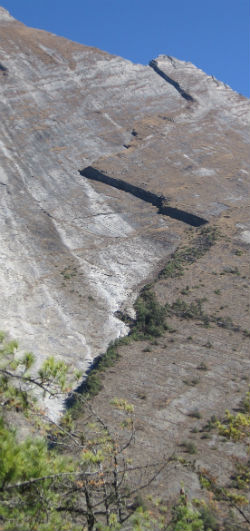
I was surprised how many older people were on the trails. Whole gray-haired tour groups trudged the paths, French and Germans. I’m pretty sure I saw a guy in a wheelchair, too.
I went by myself sans guide, porter, hiking poles and maybe brains since on the last day I made a tactical error that I will explain later. There were only a few other solo travelers. I was on a different wavelength anyway; I didn’t like starting out in the morning until the sun was hitting my face so I started later than most people and then went at my own pace, which is no pace at all but just go until I get tired.
Why is this arguably the most famous trek in the world? Maybe the most famous is the Everest Base Camp trek in eastern Nepal, but on that you are backtracking and the scenery isn’t as varied. Here, you get it all: lush, verdant mountainsides terraced with rice fields, pine forests, green mountains and behind that, huge snow-covered peaks and ridges of the Annapurnas. As you ascend, the landscape becomes rocky and dry and the poor horses, cows, mules and yaks struggle to find a sprig of anything to eat. Tall waterfalls always abound, however, and behind the brown, shrubby moonscape there is always an enormous snowy mountain in background, majestically looming over. Most of the time you are following the swift-moving Marsyangdi River, a pretty greenish gray color.
Sadly, road construction is poised to destroy the Circuit. Nepal is about to kill the Golden Goose. More on that later.
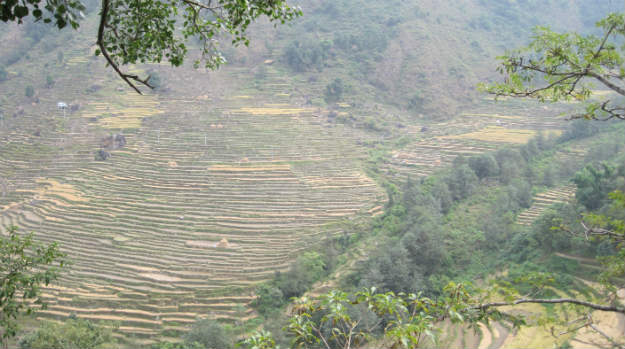
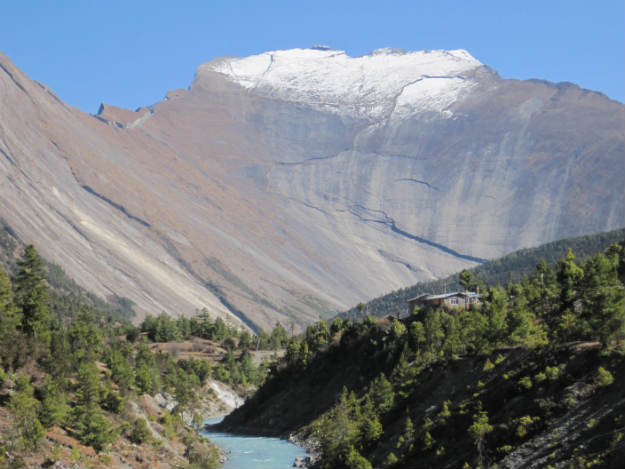
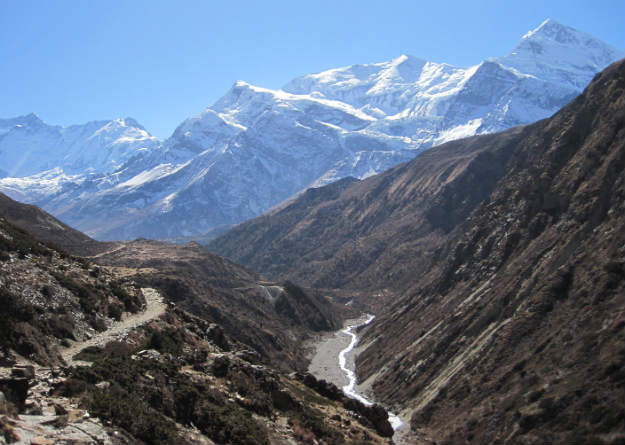
In Pokhara I scrambled to buy cold weather gear at the last minute so I ended up being dressed like a 9 year old let alone to buy his clothes for the first time: orange hat, blue gloves, red shirt, black pants, etc. and the icing on the cake was an aqua-greenish jacket that I bought hastily late the night before. I realized later it was a woman’s jacket, a very large woman who might have died in it as it had that smell. But, I got a good deal and Ol’ Bessie—yes, I am a grown man who names his jackets—came in very handy even if I did look like a lost dolphin. It was so bad that even the porters, poor guys who are usually singularly focused on carrying their oppressive loads, even they found the extra energy to snicker at my jacket, the bastards.
I was hoping to find a dead hiker my size from whom I could “borrow” his jacket and maybe some hiking poles or some better clothes. Alas, no such luck.
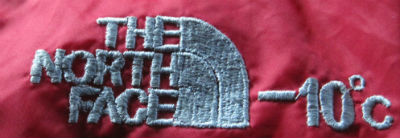
I rented this so-called -10C North Face sleeping bag, but if the bag is a fake, do I trust the -10 rating? No. In fact, this thing leaked feathers to the point that every morning I had to pluck myself.
The Annapurna Circuit is called a “teahouse trek” because you can find teahouses/lodges to sleep every couple of hours on the trail. You could even do it without a sleeping bag if you were sure you could get enough blankets at every lodge. They are simple places where the power routinely goes off, rats or some kind of vermin crawl around above and it’s generally hard to sleep from the cold drafts; the challenge was to find a warm room without gaps in the walls or windows where wind rushes through. Mainly though, I just took any place where people didn’t laugh at my jacket. Most places have solar or gas showers, and only the last three days did I not have one.
19 years ago I remember having only one (cold) shower in a week. No solar showers back then, just an ethics debate about using precious firewood to make hot water.
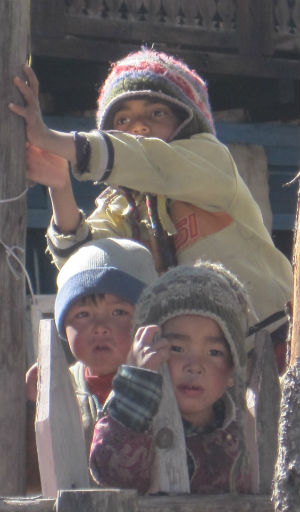
It was nice to see that even after 19 years, one thing hadn’t changed: you could be many days away from the nearest road, and enchiladas, lasagna, and pizza would be on the menu. Crazy. I got more excited about the delicious dried apples in Koto and Marpha.
You meet a special crop of people on the mountain: a semi-pro triathlete from the Faroe Islands(!) and a striking Ivory Coast/French-Canadian girl with the same name, coincidentally, the latter with a blond dreadlocked Frenchman, together making them Couple of the Year. I also saw TWO mountain bikers(!) carrying their bikes up the mountain which is the height of insanity and possibly danger, but they took the challenge with aplomb.
I also saw two families trekking, one with a seven year old that had to carry a 3kg backpack. It’s amazing what kids can do if you give them a chance, but at what point is it too much too young?
Apropos of nothing, the most incredible thing I witnessed were guys who had been out drinking in the bigger village until the night and then bringing their packs of mules down for about two hours in the dark with a weak flashlight. I didn’t see, but they were probably wearing flip-flops, too.
Some boring details that I will compensate with a photo of the Couple of the Year.
($1 = 80 Nepali rupees)
I paid 3600 rupees in entry fees and permits and I averaged about 100 rupees a night to sleep. The deal is that accommodation is very cheap, sometimes free, just so you will eat your meals there, which is how they make their money.

This couple had another way of doing the circuit on the ultra-cheap. Their strategy was to arrive in a village later in the afternoon than most people so they had bargaining leverage and then ask for a free room and discounts on the menu. They would share one dal bhat (the national dish of all-you-can-eat rice, lentil soup, and vegetable curry) between them to maybe see if they could get charged for only one. In the morning I think they just ordered hot water so they could use their own powdered milk and corn flakes. They even drank the spring water coming from the taps without purifying pills, but I got giardia this way last time. Too risky for me, but they were fine. I didn't try this method because one, I often wanted extra blankets and candles for the inevitable power outages and two, I wasn't in the mood for such slash and burn travel. They certainly made an impression everywhere they went. During this bongo session, when she became hot and took off her shawls, there was a noticeable murmur among the 5 or 10 Nepali men gathered and then in a minute there was suddenly at least a dozen more, cell phone cameras out.
I heard a story that on the Thorung La pass two French people took off all their clothes (I thought it was redundant to say they were French) for some reason and were pelted with rocks by Nepalis who were offended. Then just last night a couple told me that when they were on the pass a few days ago, an Israeli dropped his pants and the guy who runs a tiny stone tea shack at the top (which does deaden the feeling of hiking accomplishment somewhat when you see it) charged out and beat him, knocking him to the ground while his pants were still around his ankles.
I was not aware of this subculture or phenomenon or I don’t know what to call it of taking off your clothes on peaks. It is the last thing on my mind. I’m so square.
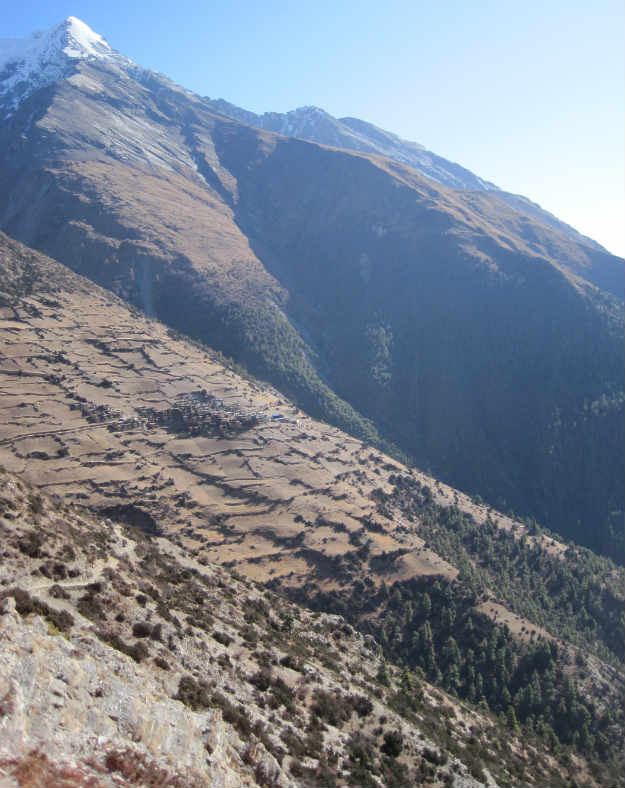
This is a view of Ghyaru and below is the woman that ran the guest house

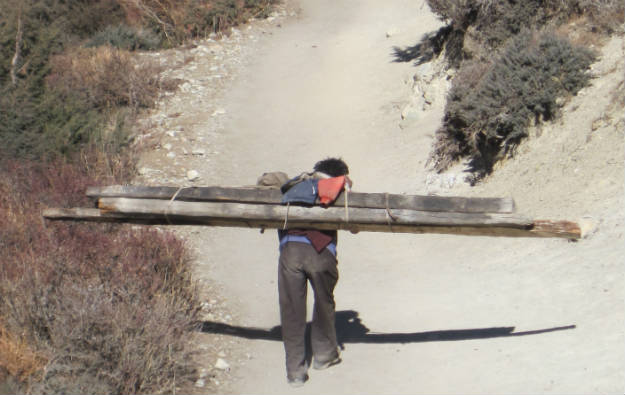
This porter is carrying what looked like four 4x4s each about 3 meters (10 feet) long. I heard he got paid 1500 rupees ($19) to take this from Manang up to Letdar, a gain of 2000 feet in elevation already above 10,000 feet. I don't think there is such a thing as an underpaid porter.
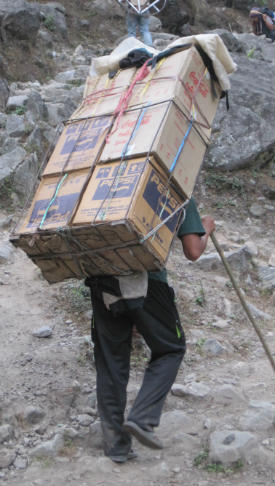
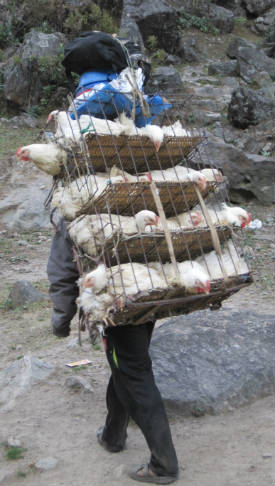
Someone told me that a porter makes 100 rupees for each 1 kg carried from Besishahar, the last of the pavement, to Manang, about a three day trip, 3000 meters up. I met two girls who paid 7000 rupees for a porter to carry their two backpacks from Manang to Muktinath. I also know that a hotel owner in Thorung Phedi, (a real scumbag, let me go off-topic for a moment to say that my only two hotel recommendations are to NOT stay at the higher of the two places in Thorung Phedi and TO stay at the New Yak Hotel in Braga) charged 7000 rupees for a horse to carry a sick Israeli girl over the pass.
I’m not in the mood right now to show off my business-economics degree to expand on this (Did you know I have a degree? I went to school! Well, I didn’t go to school, I went to UC-Santa Barbara, but still) or to go off on the Snickers index, where you can gauge local prices by what a Snickers costs or of menu price disparities relative to actual cost such as potatoes growing out back vs. Coke hauled up, but I want to keep this post under 10,000 words.
DVD Night in Manang
This title evokes Pico Iyer’s seminal book of essays, “Video Night in Kathmandu” that got me excited about traveling to Asia way back when. It’s the same thing—people huddling in a small room with a projector—in a different format. The guy who ran this shack cleverly knew that lots of hikers wanted a change of pace instead of falling asleep at 8pm every night, so we happily paid 200 rupees to watch a DVD with tea and popcorn. There was even a stove to stay warm. However, the choice of movie couldn’t have been more horrible, the schmaltzy “Into Thin Air”, the story of a Mount Everest climbing disaster. Not inspirational to get over the pass!
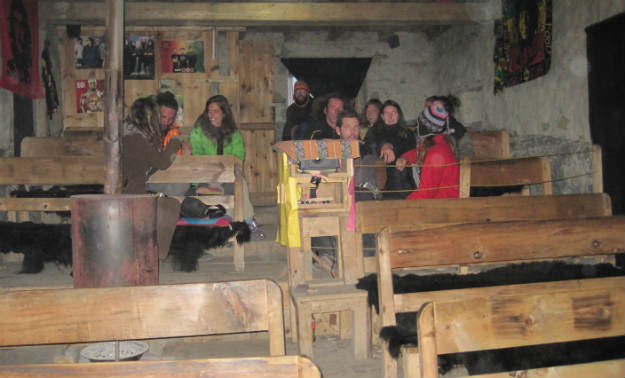
Not the best photo of the humble video parlor, but there are animal skins to sit on in lieu of cushions.
Manang is about Day 6 or 7 on the trek and where most people take a break. I sampled the local bakeries, the seabuckthorn juice and the flavorful yak cheese. Below is a photo of the woman selling the yak cheese and since they don’t have all the little weights for the scale, they throw a 50g Mars bar on for accuracy. Gotta love that improvisation.
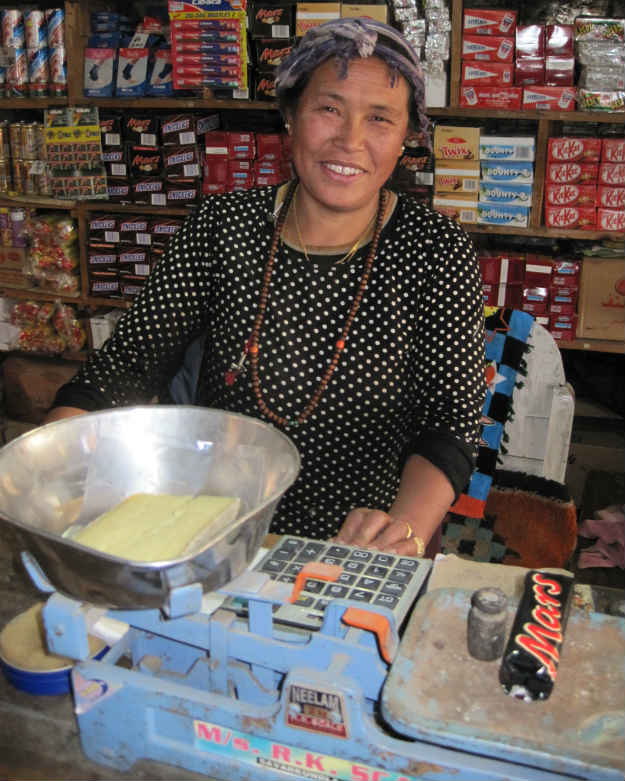
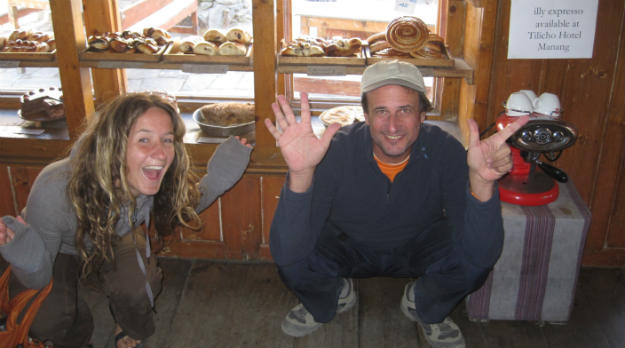
Day 7 with Mrs. Tibbo in a bakery. We're both pretty excited about the apple crumble.
In Manang I again came across four hardcore hippies “of highly indeterminate means”, as Pico Iyer would say. They were a curious group, cooking their own food and keeping to themselves. No one knew where they slept. Sleeping in a tent in these frigid conditions would be “the last word in discomfort” as Pico Iyer would also say.
Thorung Phedi is the last settlement (along with High Camp just above it) that everyone stays at the night before the ascent to the pass. It was here that I met a French guy who knew TheDromomaniac.com! He overheard us talking about it and said he had read my blog, proving so by saying I had been to Kenya and Switzerland this year. The Dromomaniac is a benign virus spreading throughout the world!
I expected that by the time I got past Manang, where it begins to bottleneck, I would know people to walk with since I gab with everyone and make an ass of myself, and I did know nearly everyone, but I was engrossed in my book, Chickenhawk, and I became the last person to to start up the mountain. For safety’s sake I wanted to avoid this, and sure enough, I had just sat for my first rest when I heard a thump about 10 meters over and a rock the size of a soccer ball blew past me. What the heck? I looked up and a herd of yaks were kicking up rocks that were racing down towards me. I was scared. With my minimal oxygen I hightailed it to a safe place until they made their way away. There would be no “death by yak” today.

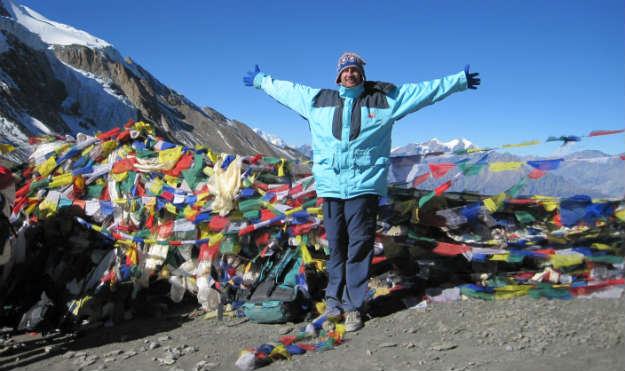
On the Thorung La pass with my clothes on. YES!
Why would anyone want to live at high elevation? The sun is too intense, you burn easily, cuts won’t heal, the dusty, dry wind parches your skin and lips, everyone’s coughing, wheezing, and hacking up phlegm like a Chinese peasant. Worst, it’s cold. The star-filled nights were impressive (not a cloud was to be seen the entire trek), but I can’t handle being out in the cold. I was already cold the night of Day 2 and then every subsequent night was an all-hands-on-deck, DEFCON-5 cold where I wore multiple layers of clothing to bed.
There’s nothing nice to be said about driving on the road back from Muktinath. It’s a dusty, nasty road for us bus passengers and for the people we blow by and create a duststorm. My only regret is that I didn’t go by the first town, Kagbeni, to see what a “YacDonald’s” restaurant looked like.
Lots of people cut their walks short if they see no alternative to the horrible road. I couldn’t decide if it was worse to walk or be on the bus. I had a young idiot driver who went right on the edge of the precipice where it was smoothest and driest, but we still bumped around and I could envision the headline: Bus Plunges Into Ravine: 14 Nepalis, 1 Formerly Handsome American Dead
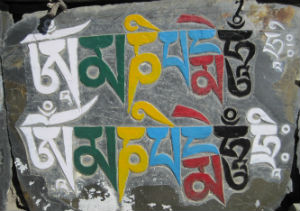
Because of a mafia-like monopolistic stranglehold on transport coming down from the mountains, it is expensive to travel back by bus and jeep, about 2000 rupees for me, and 1000 for Nepalis. I have the money, but for Nepalis 1000 rupees is a lot of money, too expensive for most. So, if private vehicles are out of the reach for 99% of the villagers and it is expensive to take a bus, for whom does the road benefit?
The Road
I need to talk about this road. Normally I am a big fan of roads, big fan of infrastructure, but this might be an exception.
The angst about the road being built on the eastern side stems from the mess that has come with the completion of the road on the western side. No one wants to trek on the western side anymore. Trekkers bring a ton of money into the economy, and Nepal is making it unattractive.
Most of the way the road is being built on one side of river and the trail is on the other, but if your village is on the other side, even if there is a footbridge, you’re toast. If your road is on the same side as your village, you can only hope you are the midpoint overnight place. For a trekker, do you want to hear the screeching bus air horns and see the dust whipped up?
One woman in Danaqyu saw the road as good, she no longer would need to walk three hours to go to the bank in Chame, but bad in that she may no longer need to go to the bank because she will have no money as tourists will go straight by her dying village.
My question is, if the road is so beneficial, why do I still see porters on it? Why would a bus or jeep go by with any extra space? Something doesn’t make sense. It’s crazy to build roads when the Kathmandu-Pokhara road has so many bad sections. That should be a ten-lane superhighway given how much money is thrown around by aid organizations.
It’s a huge undertaking. There are several points where they are simply going to carve the road out of the nearly vertical rockface. On the surface the army is building the road because the private sector is too corrupt, I was first told, but then I heard that they were needed to quell protesting villagers. Is someone else behind it? The Chinese? The road on the western side now goes from Pokhara to Jomsom and on to Tibet. Lots of intrigue here.
Nevertheless, even if I think the road is going to ruin it, if I told some young punk in a couple of years from now that the Annapurnas used to be a circuit and it used to be a hike all the way around and how special it was back in the day, he’d say, “That’s great, Pops. When you’re done reminiscing about wooden tennis rackets and playing Donkey Kong, wake me up when you can tell me where I can get a latte with soy milk.” The past has no relevance. There are always alternatives, other treks, other stimuli.
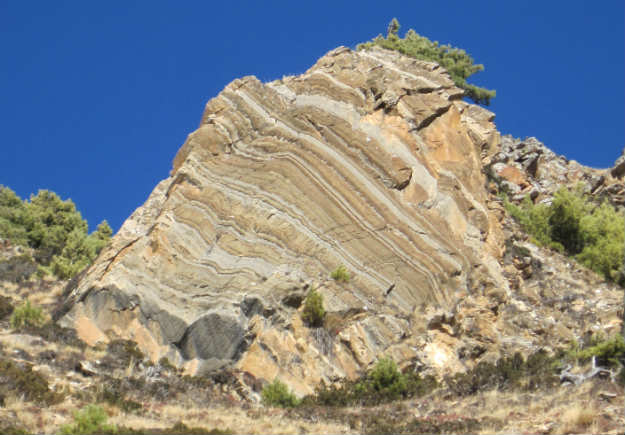

Very interesting post! When we hiked it, we flew from Jomson back to Pokhara. Most exciting flight I’ve ever been on (and I’ve been on some doozies!) and I’ll never forget it. Sad to think about the road. It was nice to be away from machines.
Thanks!
As I recall, Pokhara “airport” used to be just a big shady tree!
Did the Annapurna circuit in 1978. Trekked clockwise because we had tents to camp a few hours above Muktinath. Your description of the roads is very depressing!!
In your blog on Kathmandu, you mentioned KCs as being new. Actually it was one of the 1st restaurants in Thamel.
http://www.flickr.com/photos/sonomapicman/5291434245/
I don’t know why I implied that KC’s is new since they even have a sign out front stating how old they are!
That Annapurna road is really depressing and now you aren’t even allowed to trek by yourself. It’s really a shame.
So you did the Jomsom-Muktinath trek? Sounds like you didn’t think too highly of it? I was thinking about doing the same thing, flying up to Jomsom, checking out the Plateau, and then walking back down to Pokhara over how ever many days – in the August Monsoon. Well, I guess if it sits in a rain shadow…
Just wondering what you thought of it.
I did it once a long time ago before they started working on the road. I did the opposite my last time there. Plateau?
Do you have to go in the monsoon? If it is late August maybe you get lucky, but it doesn’t sound fun to me if you do get wet!
I do have to go in monsoon! I’m in school September-May. I thought about going in May and June but somehow I think it’s worse in that premonsoon heat. I was in India last spring and it was unreal hot, also it’s so dusty that mountain visibility *seems* like it would be worse than on a clear morning in monsoon.
Rain’s okay with me, at least everything is green and the temperatures drop a solid few degrees. Any experience in South Asia in summer?
I try and avoid South Asia in summer, but I was once in Mumbai when they had record rain. I didn’t enjoy it.
Nice jacket! (sniggers)
Next time I might Fedex it to you!